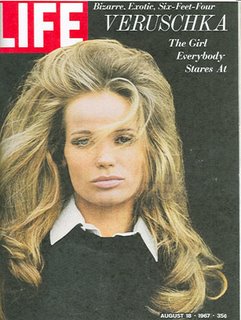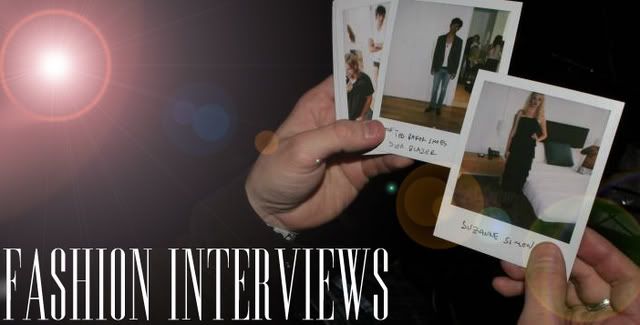Veruschka (Feb, 2003)

Veruschka was no ordinary '60s model; a German countess, she could be anything from Greta Garbo to a leopard in a tree. Now, at 61, she is still an inspiration.
Of all the players in Michelangelo Antonioni's cult 1966 film BlowUp, there was one legendary enough to star as herself.
Veruschka - the model whose farout features dominated fashion magazines in the late '60s - appeared for hardly five minutes, but her performance was electrifying.
Announcing herself ("Here I am") at the studio of the David Bailey-esque photographer (played by David Hemmings) barefoot and in a black mini-dress, she proceeded to seduce the photographer's lens by writhing on the floor like a wildcat, while he sat astride her, snapping furiously."
She moves like nobody on earth," Hemmings sighed afterwards.
In real life her photo shoots were no less extraordinary; US Vogue editor Diana Vreeland would give Veruschka carte blanche to conceive fashion stories with her then lover, the Italian photographer Franco Rubartelli.
The leotard-clad Veruschka and Rubartelli would jump on a plane together, taking all the clothes, body paint and photographic equipment they needed to the middle of a desert, or to some snowy wasteland against which Veruschka would throw her lean body into contorted shapes. They once travelled to the Bahamian island Eleuthera on Christmas Day to take photographs by moonlight.
You would expect such an astonishing figure to make an entrance. But when Veruschka, now 61, arrives at a Parisian photographic studio, she glides in swiftly, shrouded like a brightly coloured Lawrence of Arabia.
Within seconds she has disappeared into a back room for a further hour to apply her make-up.
Veruschka, who now goes by her real name, Vera von Lehndorff, is in Paris to meet the New York fashion designer Michael Kors, who chose to capture her spirit in his spring/summer 2003 show for the French fashion house Celine.
To a sitar-laden remix of the Rolling Stones' Jumping Jack Flash, Kors sent on to the catwalk a collection he dubbed Veruschka Voyage, a holiday wardrobe gleaming with gold embroidery and hot pink and orange tie-dyes.
Kors's models looked like leisured, sun-tanned bohemians, sporting collar-bone-skimming earrings made of linked brass discs.
Today, von Lehndorff is just here to hang out while the photographer Vincent Peters shoots the Celine advertising campaign with the 27-year-old Midwestern model Frankie Rayder, who appears airily unconcerned about measuring up to one of modelling's all-time greats.
Von Lehndorff's pale, heavily lined face and broad features remain impassive as she draws on a cigarette. Her ensemble is on the outer reaches of eccentricity; over her taut body she wears something resembling a black body stocking, a floor-length orange cardigan and a raggedy orange tie-dyed scarf.
On her size-nine feet are Vivienne Westwood pirate boots, and her straggly tawny hair hangs from under an orange bandanna decorated with spangles.
Odder still, earlier in the day this look was completed with a pair of orange-lensed Ali G-style sunglasses.
However, von Lehndorff's career as a model has had unusually little to do with clothes. As she said to Nova magazine in 1968, "I hate the whole kind of chic look - Dior, St Laurent. They might look very nice, but I don't feel them." And her attitude hasn't changed. "I'm not especially inspired by fashion," she says slowly in her contralto, Germanic voice, before giving the rail of Celine outfits a polite but cursory survey. For von Lehndorff, modelling was all about transforming herself. "I was always being different types of women. I copied Ursula Andress, Brigitte Bardot, Greta Garbo. Then I got bored so I painted myself as an animal," she says in a deadpan way. "One day I ended up as a stone. I was depressed and went out on to my terrace in Rome. I wanted to disappear, to be like the stones of the terrace. I painted myself lying down in the mirror, and copied the stones on to my face."
But at the beginning of her career, changing was a necessity, not an artistic, endeavour. She had first travelled to New York in 1961 as plain old Vera, but failed to secure a single booking. After retreating to Milan for a spell, she returned to take Manhattan under her new name, Veruschka.
"I dressed all in black and went to see all the top photographers, like Irving Penn, and said, 'I am Veruschka who comes from the border between Russia, Germany and Poland. I'd like to see what you can do with my face.' "
It worked; constantly booked, Veruschka gained almost mythical status. When Life magazine profiled "the most sought-after model in the world", they magnified her 1.8-metre frame to an alien 1.9 metres. Her extraordinary physique, complete with outsize hands and feet, even spawned industry rumours that she had once been a man.
Von Lehndorff's background is as intriguing as the Veruschka creature she invented. Of noble birth, her full title (which she never uses) is the Countess Vera Gottliebe Anna von Lehndorff. Her father was a Prussian count who was involved in a plot to assassinate Hitler in 1944 and hanged that year, when Vera was three. Her mother was arrested, and Vera and her sisters spent the rest of the war in Gestapo camps. They were reunited with their mother after the war, but the family was destitute, and ostracised by other Germans for their father's treachery. She ended up studying textile design in Florence, where a fashion designer first asked her to model.
Von Lehndorff stopped modelling in the early '70s when the newly appointed editor-in-chief at Vogue, Grace Mirabella, advised her to cut her hair so readers could identify with her ("I hate that idea"). She then sought to become "an artist who had modelled for a few years". Collaborating with the artist Holger Tradilzsch, she was photographed in 1971 and 1972 as a series of characters, clad only in body paint.
Although she has made the odd foray back into modelling (for example, to launch a menswear collection for Karl Lagerfeld in 1995), von Lehndorff lives the life of an artist in a rundown area of Brooklyn, with her lover Micha Waschke, a musician who doubles as her assistant. She has exhibited a steady stream of work, from photos of herself covered in ash to a short film, Buddha Bum (1998), in which she plays a series of homeless people and Buddha.
It is unfortunate that von Lehndorff talks about her art in the kind of indistinct terms that smack of half-baked pretension. "Veruschka was the first emanation of the children of illusion," she murmurs, referring to her sprawling work in progress, Emanations. Since the mid-'90s, she has collaborated with designers ranging from Helmut Lang to Paco Rabanne to explore characters that include "urbanites and savage animals, presidents and movie stars". But the results are compellingly strange, and far from anachronistic.
The fashion world fosters an ongoing fascination with her '60s persona, the make-up brand MAC sells a lipstick called Veruschka, and there are still boutiques named after her, yet she is detached from any hype. Asked if she misses the glamour of modelling, she looks down her wide, flat nose unselfconsciously: "No. I have my own drama and glamour anyhow. As long as I am here, it is not gone."
"Oh, I think she's more glamorous than she ever looked in her pictures," designer Michael Kors chips in, which is plainly untrue. But in fashion, where myths can hold more sway than reality, Veruschka will always be an extraordinary beauty.




0 Comments:
Post a Comment
<< Home